Mako 264
by David Pascoe
A center console, narrow beam (8'6") open fisherman deep vee hull. We surveyed a 1992 model (in mid '97) fitted with a full tower, dual controls and twin Evinrude 200's mounted on an aluminum transom bracket bolted to the hull. It had an extensive electronics package, including autopilot, Furuno CVS, Trimble NavTrac and many others. The boat had spent its entire life in the Cayman Islands and was kept on davits. The 203 gallon fuel tank gives it fairly good range.
Without a tower, there is nothing impressive looking about this one. The hull style is rather plane-Jane and looks like a mold that's been kicking around south Florida for quite a while. One feature is that it has recessed trim tab pockets. Cockpit has built in rod racks each side, two fish wells, bait well aft, anchor locker in vee up forward and storage under open bow seating forward.
I wasn't particularly impressed with the center console layout which has Morse shift and throttle controls mounted down low at just above knee level, on an angled forward face. It was okay for the shifters, but having to lift the throttles up to accelerate was awkward and difficult, a major design flaw. Steering and engine instrument placement was generally good.
With a 14' tower (above W/L) I expected this boat to be a bit tender and roll excessively, but I was pleasantly surprised. The real strong suit of this boat is, in a word, performance. Flying along at around 40 MPH in a narrow section of the Intra coastal, crowded with other boats and lots of big wakes, the motion in the tower was surprisingly smooth. No heavy bucking, pitching or rolling. She is a heavy boat with a very nice ride, as well it should be with such a narrow beam and deep vee. When hull slams, there are not a lot of loose parts rattling and making noise, common to so many other boats. It actually felt better running from the tower than the lower station, which is unusual. For an outboard, she would pivot on a loose axis and backed down reasonably well. During docking, I could crab her sideways toward the dock very nicely.
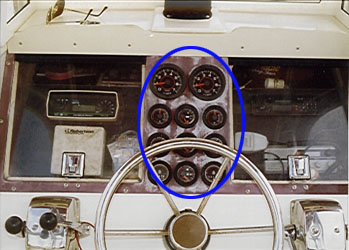
The helm layout can only be described as poor, with engine controls poorly placed down low, electronics cabinets that leak badly, and a plastic instrument panel that deteriorated after only 4 years.
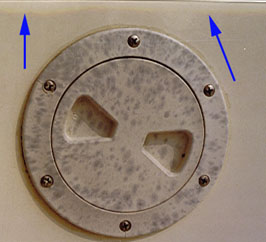
More cheap plastic parts. There are 7 of these on this boat with the plastic badly mildewed (permanent) and they all look like this. Also note the bad gelcoat blending (molding defect repairs) which ages to a discolored state like this.
Originally she had a middling price and overall quality is about the same. The decks are plywood cored; the console is screwed to the deck and it looks like water got into the core on one side as evidenced by a soft spot. There was virtually no access to the internal hull, not on the sides or the bottom, all of which seems to be filled with foam for positive floatation. Tower was bolted screwed to deck but there weren't any significant stress cracks anywhere. Hull had no blisters. Here are a few of our gripes:
- Red rubber rub rail with insert is sun damaged, checked, badly discolored and very ugly.
- I have nightmares about foamed in aluminum fuel tanks and this boat has one. It has one of those lovely plastic access ports above the fuel gauge and valves that doesn't seal and leaks water onto the tank top. The problem with foamed tanks is that water collects on the bottom side of the tank (no, the foam doesn't prevent water from contacting it because aluminum tanks expand and contract) and there is no way to determine the condition short of tearing it out.
- Same goes for red molded plastic instrument panel which was very badly faded.
- Console front seat has open gap at top which allows water inside of console; battery boxes were full of water and batteries dead.
- Morse control heads leaked water onto wiring under console.
- Batteries are mounted in those hideous, el cheapo plastic battery boxes with the belt-buckle straps. The "d" brackets holding the straps cut through them and batteries were sliding around, working all the terminal connections loose.
- Transom is marginally reinforced for tremendous leverage created by the motor bracket. The transom laminate immediately below the bracket was delaminated.
- Holes cut for engine controls cut through plywood cored transom were not beveled or sealed with stress cracks developing and possible water into core.
- Cheap plastic access ports (7 of them) - plastic chalky and very badly mildewed, very unsightly.
- Only one bilge pump with no space to add another.
- Plumbing for bait wells and drains uses all plastic parts and plumbing is rather sloppy.
- Navigation lights didn't meet U.S.C.G. requirements.
- Stress cracking occurred along chines in after half, and on boat in forward section but not sufficient to indicate potential structural failure, but does indicate some weakness.
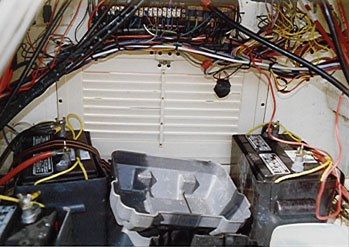
Pay $80k for a boat and you hope to get something a little better than this mess. Shoddy wiring and batteries in el cheapo plastic boxes held with belt buckles.
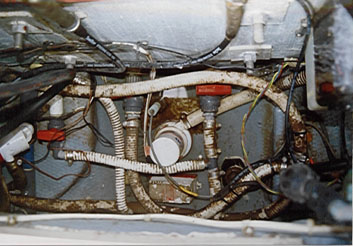
The aft bilge is a rat's nest hoses, wires and cables and very difficult to reach.
This boat had been sitting out in the Caribbean sun for 4 years uncovered and looks ten years old. With a sale price of around $25k, the seller lost about 60% of his investment in just four years. This was partly due to over investment in extra equipment, but also poor maintenance. But a few design flaws and a lot of plastic didn't help.
 Visit davidpascoe.com for his power boat books
Visit davidpascoe.com for his power boat books 


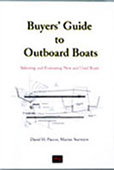











David Pascoe is a second generation marine surveyor in his family who began his surveying career at age 16 as an apprentice in 1965 as the era of wooden boats was drawing to a close.
Certified by the National Association of Marine Surveyors in 1972, he has conducted over 5,000 pre purchase surveys in addition to having conducted hundreds of boating accident investigations, including fires, sinkings, hull failures and machinery failure analysis.
Over forty years of knowledge and experience are brought to bear in following books. David Pascoe is the author of:
In addition to readers in the United States, boaters and boat industry professionals worldwide from nearly 80 countries have purchased David Pascoe's books, since introduction of his first book in 2001.
In 2012, David Pascoe has retired from marine surveying business at age 65.
On November 23rd, 2018, David Pascoe has passed away at age 71.
Biography - Long version